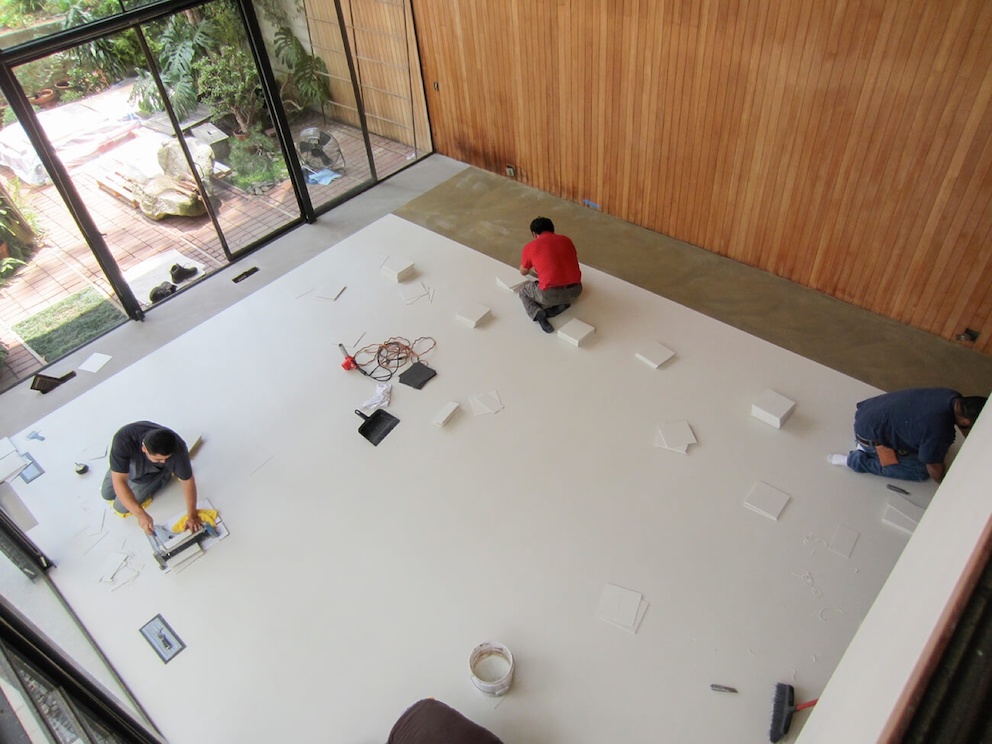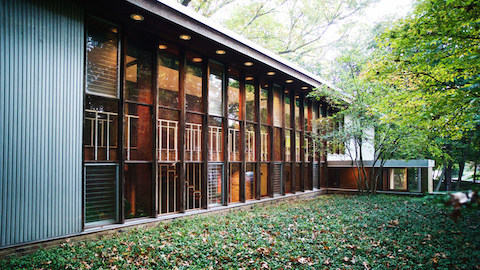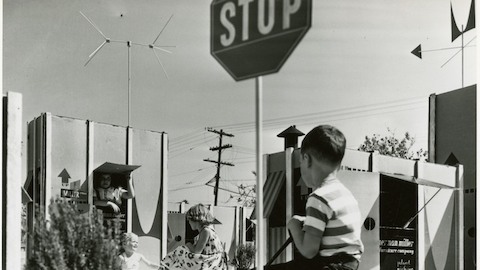Strolling up the drive to Charles and Ray Eameses’ now-iconic 1949 residence in Pacific Palisades, California, is like stepping into another world—a tree-lined, flower-filled sanctuary that’s far removed from the city streets below. If it’s a cool morning, mist will roll in from the Pacific and hover above the ocean-side bluff where the house resides. With that mist comes the tang of sea salt, mingling with the scent of eucalyptus and wafting through the copse of over 200 trees that populate the surrounding meadow.
A Modernist Masterpiece
The home itself is like something out of a dream—or, rather, Charles and Ray’s playful yet pragmatic minds. The pair devised the house as part of Arts & Architecture magazine’s Case Study House Program, which challenged architects to design homes that reflected life in the modern world using techniques and materials developed during World War II. In a design brief published in the December 1945 issue, Charles wrote that the home, “in its free relation to the ground, the trees, the sea—with constant proximity to the whole vast order of nature—acts as reorientor and ‘shock-absorber’ and should provide the needed relaxations from the daily complications arising within problems.”
The result, Case Study House No. 8, is a modernist masterpiece. The residence and studio, dual steel boxes nestled into the bluff, are exclusively comprised of off-the-shelf materials: black-painted steel beams and glass panels interspersed with rectangles of white, gold, orange-red, and blue. Placed behind a row of eucalyptus trees, the home’s precise, geometric shapes and engineered materials integrate effortlessly with the natural world. The structures live lightly on the land, taking advantage of the trees’ shade and beauty without encroaching on them.
Preserving the Home
The magic of the Eames House and landscape has fared well since Ray passed away in 1988. After her death, Charles and Ray’s daughter, Lucia Eames, maintained the home with support from founding sponsors including the Eames Office, Herman Miller, and Vitra. Today, the Eames Foundation is responsible for its care and operations. Over the years, the Foundation has worked with several organizations as part of its 250 Year Project—the Foundation’s plan for ensuring that future generations visiting the house may enjoy the same authentic experience as people do today.
“To succeed with the 250 Year Project, we need to approach the conservation of the Eames House with a plan that balances the differing needs of the structures, objects, and landscape, while still showing how Charles and Ray lived and worked there,” says Lucia Dewey Atwood, granddaughter of Charles and Ray and Director of the Eames Foundation 250 Year Project. “We need to anticipate repairs. Think about the possible solutions for replacing the roof. If you are looking at things from a 250-year perspective, it’s quite likely you’ll make different decisions than you would looking at them in a 20-year context.”
In 2011, the Eames Foundation loaned the contents of the living room to the Los Angeles County Museum of Art for a temporary exhibit. This gave the Eames Foundation the opportunity to work with Escher GuneWardena Architecture (EGA) and the Getty Conservation Institute (GCI) to conduct research and implement the best methods for addressing urgent deterioration issues.
Says architect Ravi GuneWardena, who has preserved and renovated homes by other mid-century architects like Richard Neutra, A. Quincy Jones, and John Lautner: “Each of these houses have very specific characteristics that have to be studied and dealt with uniquely. What is essential, however, is developing a system for researching all materials available for each house, deciphering the architectural intent of the original authors, and documenting every step in the conservation process so that someone can follow your methodology in the future.”
That’s exactly the approach EGA, GCI, and the Eames Foundation have taken since the beginning of the conservation project, when they replaced damaged floor tiles, made repairs to the home’s steel structure, and worked with engineering firm Wiss, Janney, and Elstner Associates to replace the roof.
From Tree to Table
The preservation work extends to the landscape too. To maintain its health, every few years the Foundation prunes and occasionally fells several eucalyptus trees. To replace them, the Eames Foundation encourages volunteer seedlings to grow and plans to plant more trees in the future.
As stewards of the Eameses’ legacy of sustainable design, Herman Miller and Vitra—the only official makers of original Eames furniture—are taking the felled eucalyptus trees just as seriously as Charles and Ray did while designing the house in the late 1940s (so much so that they finished their living room wall in eucalyptus wood). Working closely with the Eames Foundation, Herman Miller and Vitra have created solid eucalyptus tops for a limited run of Eames Eucalyptus LTR Tables, available September 6 in North America and late October in Japan through Herman Miller, and in Europe and the Middle East, through Vitra, starting September 6.

Illustration by Elisabeth Moch based on Eames Foundation tree census, 2014, by Carlberg Associates, Santa Monica, CA, and drawn from the Conservation Management Plan, a partnership between the Getty Conservation Institute and the Eames Foundation. Numbers identify the location of the trees recently harvested and used for Eames Eucalyptus LTR Table tops.
What’s Next
The tree removal and subsequent creation of the Eucalyptus LTR Tables are just a small part of a broader Conservation Management Plan (CMP). “It seems particularly appropriate that the CMP was published this year: the home’s 70th anniversary,” says Dewey Atwood. “A tool for realizing the promise of the 250 Year Project, the CMP provides critical guidance as we prepare a master plan for the continuous conservation of the entire site.”
“The CMP starts with the history of the house and its design, its physical features, and how the house embodies Charles and Ray’s creative spirit,” says Chandler McCoy, GCI project manager for the conservation project. “From there, it identifies what is significant about the Eames House—the architecture, the collection inside the house, and the surrounding landscape, including the eucalyptus trees—and present policies that will protect its significance. All three elements have to be managed appropriately.”
The importance of this work extends beyond the preservation of the Eames House. Learnings from the project are setting new standards for conserving mid-century homes, so the design impact of these historic gems will not fade with time.
What’s sure not to fade is Charles and Ray’s playful, colorful approach to both design and living, which is so apparent in the Eames Home and its landscape. With vanguard research and insight from GCI, and ongoing support from partners including Herman Miller and Vitra, this legacy is sure to thrive—and to be enjoyed by many—for years to come. If you’d like to support the Eames Foundation and its ongoing work to preserve the Eames House, please visit https://eamesfoundation.org/support/donations/.













